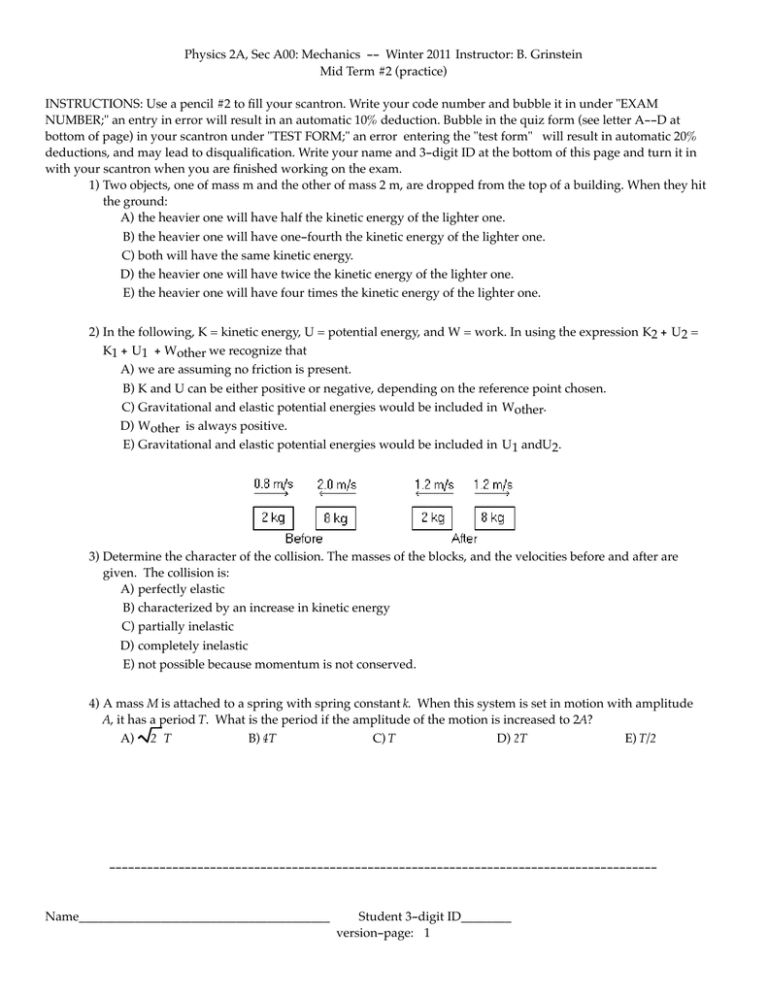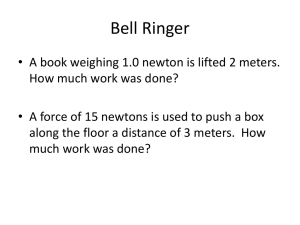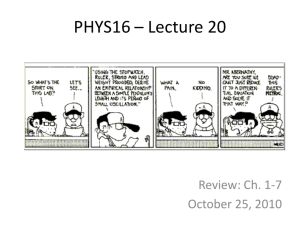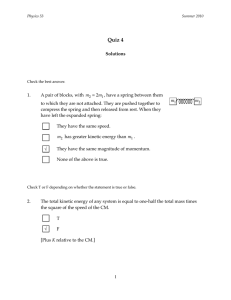Physics 2A, Sec A00: Mechanics -- Winter 2011... Mid Term #2 (practice)
advertisement

Physics 2A, Sec A00: Mechanics -- Winter 2011 Instructor: B. Grinstein Mid Term #2 (practice) INSTRUCTIONS: Use a pencil #2 to fill your scantron. Write your code number and bubble it in under "EXAM NUMBER;" an entry in error will result in an automatic 10% deduction. Bubble in the quiz form (see letter A--D at bottom of page) in your scantron under "TEST FORM;" an error entering the "test form" will result in automatic 20% deductions, and may lead to disqualification. Write your name and 3-digit ID at the bottom of this page and turn it in with your scantron when you are finished working on the exam. 1) Two objects, one of mass m and the other of mass 2 m, are dropped from the top of a building. When they hit the ground: A) the heavier one will have half the kinetic energy of the lighter one. B) the heavier one will have one-fourth the kinetic energy of the lighter one. C) both will have the same kinetic energy. D) the heavier one will have twice the kinetic energy of the lighter one. E) the heavier one will have four times the kinetic energy of the lighter one. 2) In the following, K = kinetic energy, U = potential energy, and W = work. In using the expression K2 + U2 = K1 + U1 + Wother we recognize that A) we are assuming no friction is present. B) K and U can be either positive or negative, depending on the reference point chosen. C) Gravitational and elastic potential energies would be included in Wother. D) Wother is always positive. E) Gravitational and elastic potential energies would be included in U1 andU2. 3) Determine the character of the collision. The masses of the blocks, and the velocities before and after are given. The collision is: A) perfectly elastic B) characterized by an increase in kinetic energy C) partially inelastic D) completely inelastic E) not possible because momentum is not conserved. 4) A mass M is attached to a spring with spring constant k. When this system is set in motion with amplitude A, it has a period T. What is the period if the amplitude of the motion is increased to 2A? A) 2 T B) 4T C) T D) 2T E) T/2 --------------------------------------------------------------------------------------- Name________________________________________ Student 3-digit ID________ version-page: 1 5) Under what conditions is the motion of an object limited to a finite region of space for one dimensional motion? A) The object has positive potential energy. B) The object has a positive kinetic energy. C) The object has a total energy less than the potential energy it would have at some locations on both sides of it. D) The object has positive total energy. E) The potential energy reaches a relative maximum on either side of the object. 6) A potential energy function for a certain system is given by U1(x) = Cx 2 + Bx3. The potential energy function for a second system is given by U2(x) = A + Cx 2 + Bx3, where A is a positive quantity. If an object begins at the same initial position with the same initial velocity in both systems, how is the motion in the two systems related? A) The motion in the second system will be at greater speeds in one direction and lower speeds in the other direction relative to the first system. B) The motion in the two systems is identical. C) The motion in the two systems will be in opposite directions. D) The motion in the second system will be with greater speed than in the first system because of the greater potential energy. E) The motion in the first system will be with greater speed than in the second system because of the lower potential energy. 7) A ball of mass m is suspended from a rope of length R. The ball is set into freely-swinging circular motion in a vertical plane. The centripetal acceleration of the ball at the top of the circle is 8 g. The centripetal acceleration of the ball at the bottom of the circle is closest to: A) 12 g B) 13 g C) 10 g D) 11 g E) 14 g 8) An 8.0 kg block is released from rest, ν1 = 0 m/s, on a rough incline. The block moves a distance of 1.6 m down the incline, in a time interval of 0.80 s, and acquires a velocity of ν2= 4.0 m/s. The average rate at which the friction force does work during the 0.80 s time interval is closest to: A) +20 W B) -40 W C) -20 W D) +40 W E) zero version-page: 2 9) A 1000-kg car approaches an intersection traveling north at 20.0 m/s. A 1200-kg car approaches the same intersection traveling east at 22.0 m/s. The two cars collide at the intersection and lock together. Ignoring any external forces that act on the cars during the collision, what is the velocity of the cars immediately after the collision? A) 29.7 m/s in a direction 47.7° east of north B) 15.1 m/s in a direction 52.8° east of north C) 21.1 m/s in a direction 47.7° east of north D) 21.1 m/s in a direction 47.7° west of south E) 21.1 m/s in a direction 52.8° east of north 10) Starting from rest, a roller coaster descends 35 meters in its initial drop and then rises 23 meters before going over the first hill. If a passenger at the top of the hill feels an apparent weight which is one half of her normal weight, what is the radius of curvature of the first hill? Assume no frictional losses, and neglect the initial speed of the roller coaster. A) 48 m B) 96 m C) 92 m D) 140 m E) 12 m version-page: 3 Answer Key Testname: MIDTERM2-PRACTICE 1) D 2) E 3) C 4) C 5) C 6) B 7) A 8) C 9) B 10) A --------------------------------------------------------------------------------------- Name________________________________________ Student 3-digit ID________ version-page: 4




